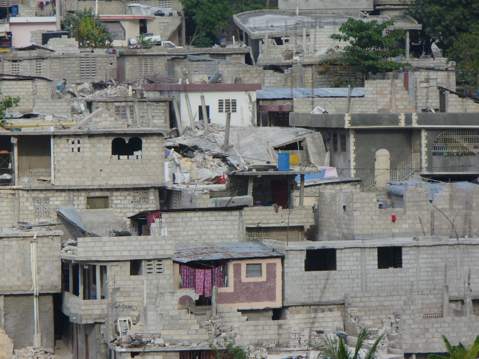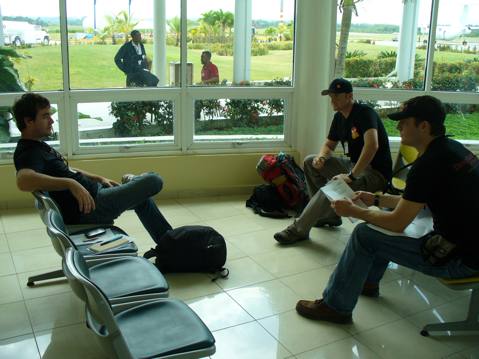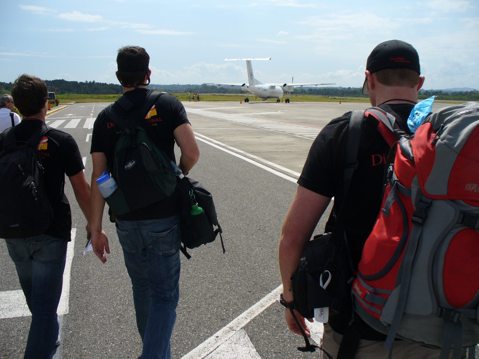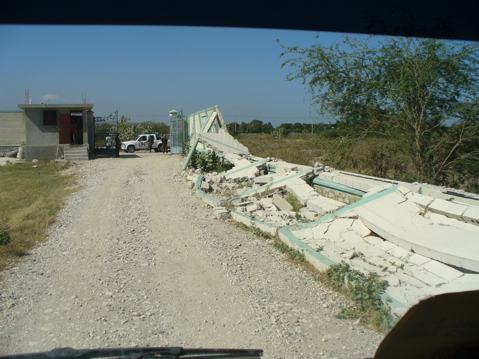Helping Kids and Scoping Spots
DRI Arrives in Haiti, Delivers Medical Aid to Children's Hospital, Searches for Warehouse to Store Supplies

Logistics for a relatively small nonprofit can be tough when the response is taking place on a grand scale. From coordinating drivers to finding phones that operate in-country to making sure shipments arrive on time, the tasks add up quickly for small staffs trying to help in a sea of aid workers.
Consider the first full day in Haiti a success for Direct Relief International, which was able on Tuesday to deliver 16 pallets of medicines and supplies to St. Damien’s Children’s Hospital. While originally scheduled for Monday (the day we flew into Haiti from the Dominican Republic), the process slowed to a halt because of a couple factors: The border closes at 6:00 p.m. each night, and it normally takes three hours to get to the border from Port-au-Prince; we arrived in Port-au-Prince too late in the day for us to leave from there to meet the supply drivers at the border — who were coming from the Dominican Republic — before closing time.
The other problem: making sure the drivers — one of whom was Spanish-speaking, the other who speaks Creole — were able to navigate their way to the hospital on their own as they, contrary to the original plan, did not wind up rendezvousing with us at the border on Tuesday but instead made the trip to St. Damien’s by themselves. The drivers, coordinating with DRI staff in Santa Barbara, made it all the way to the hospital, and, despite wanting breakfast, were in good spirits when we arrived. After conferring with staff at the hospital, we were able to get directions from the new warehouse manager, a man named Carlo who had been recently appointed to the position. Carlo, from Los Angeles, spent a year-and-a-half at the hospital two years ago, and returned to help just three days earlier.

Popping open the back of the box trucks, we were surprised to find some of the pallet loads had already been dissembled. Added to the ongoing logistical nightmare, the back ends of the trucks didn’t line up evenly with the dock of the warehouse, meaning the four of us, combined with a team of Haitians, had to dissemble the pallets and hand down box after box, extending what would’ve been a rather quick process into one of several hours. But thanks to the shipment, the Children’s Hospital now has $960,000 in children’s Tylenol, cough medicine, diapers, and Imodium that it didn’t have before.
A tour of the hospital by a New Zealander, Cassandra, who had been working in the Dominican Republic but came over to Haiti to help, showed a brief glimpse of the suffering taken on by the Haitian people, particularly children. Room after room was filled with kids who had been injured by the quake. More children were wearing casts than not, and many stayed in beds with no one by their side. Still, smiles managed to form on their faces at the site of their friend Cassandra. One boy in particular — outfitted with two leg casts with a pole connecting them to keep them from moving — had an enormous smile while beckoning and waving at Cassandra to come visit for a brief moment. The hospital, which had 150 beds but was at one point seeing roughly 700 people at a time, had quieted down considerably since then. Even then, several tents had been arranged and prepared to serve as post-operating resting places for Haitian children about to go into surgery, and more than one aisle way contained beds with people on them.
We arrived in Haiti Monday afternoon from a different airport in Santo Domingo — La Isabela International Airport — than we had originally flown into. When DRI emergency response coordinator Brett Williams originally flew to Haiti three days following the earthquake, the terminal wasn’t used and security was scarce. They were essentially just piling people onto helicopters over to Haiti. At that time, however, the World Food Program wasn’t up and running as it is today. The flight over was quick and painless, with the 20-passenger plane only slightly more than halfway filled. A cloudy cover kept us from seeing much of the ride.

On the flight over, Williams explained that Direct Relief, though relatively small in manpower with about 50 staff, was willing and able to do more than many organizations. “Our comparative advantage is we already know everybody, we already know where all the health care sites are.” While he was speaking of Direct Relief’s relationships with the approximately 15 clinics it supports in Haiti and the work it’s been doing in the country since the 1960s, it was clear that this was not Williams’s first rodeo.
From speaking to the head man of the United Nations Log Cluster (which coordinates logistics), to coordinators with the World Health Organization, to personnel with Paul Farmer’s Partners In Health, Williams worked his way around the UN compound in Port-Au-Prince, speaking with people he had made past relationships with, having worked with many of them on the earthquake in Pakistan in 2005 and the tsunami near the Indian Ocean in 2008. And it doesn’t take long for Williams and fellow DRI team members Andrew MacCalla and Gordon Willcock, who have similar experiences abroad, to start establishing new connections, with the hope that they can eventually reach out with the supplies both on the way to Haiti, as well as those sitting in DRI’s expansive warehouse ready to be sent.
The big question at this point is where DRI will be hosting the tons and tons of supplies that are on their way from the United States, both by air and by sea. The three are on the lookout for potential warehouse spaces, as well as people who might be able to use the medicines DRI has in abundance and is shipping to Haiti. Williams and Willcock scouted a potential warehouse Tuesday, but at $8,000 a month, the price is steep for the structure, which wouldn’t accommodate a fork lift and had weird spacing, according to the two. They are torn, however, given the proximity to the airport, office and kitchen space available, and security offered.

It appears temporary supply housing has been found, through a coordinated effort with the World Health Organization. A shipment of 60 pallets worth $16 million — basically all drugs — is scheduled to arrive Friday, and will be brought to the PROMESS, a staging area for WHO. They have sectioned off a barbed wire area protected by U.S. military for DRI to keep their stuff as a short-term solution before proper warehousing is secured.
The Direct Relief International group is now joined by Nadine Mondestin, who works for a DRI partner in north coast city of Cap-Haitien and is joining us for two weeks. Having grown up in Haiti, but spending more than a decade in Canada, she is fluent in both Creole and English, and has proven invaluable at a great many things, perhaps the least of which was securing a truck for the day for $100. The prices of vehicles, gasoline, hotels and more have skyrocketed since the earthquake. That, combined with larger groups sucking up warehouse space, has complicated the search. The group finds itself at a hotel in Port-au-Prince found by Mondestin, a bit off the beaten path but anything but empty.
Also staging here are more than 50 people with CBS News, including reporter Michelle Kosinski, whose report on allegedly kidnapped Haitian orphans we watched on a feed as she was returning from taping it at the airport. Also here is a group from touchglobal.org. The drive from the logistics center proved to be dirty and slow due to traffic, riding in the back of the pickup truck. Interestingly, looks from Haitians ranged from glares to stares, with little to no smiles or welcoming gestures. Many, however, asked for meals and water. Driving along a main drag, Williams noted that just weeks earlier bodies had been piled along the center median we were now driving along.



